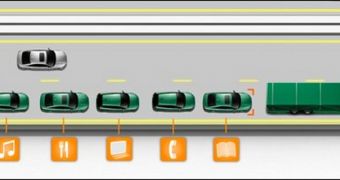The European Union has already commissioned a new study, which aims at discovering the costs, opportunities and possible obstacles that would hinder the development of a new system of using public roads. The officials want to learn if it would be possible to create what they refer to as “road trains”, which will in fact be nothing more than groups of cars navigating the streets, each of them in constant communication with the one in front of it, and the one in the back. The current research project is entirely oriented towards finding a cheap way of incorporating wireless sensors in existing vehicle, the BBC News reports.
According to some of the scientists involved in the new investigation, each of the new road trains could contain up to 8 vehicles, ranging from average, personal cars, to buses and trucks. All these types of motorized vehicle will be mixed together inside the trains, in an attempt to create a traffic infrastructure that would essentially curb fuel consumption, emissions, travel times and congestion, all through the very same system. Preliminary reports on the issue have already determined that up to 20 percent of current fuel levels could be saved if cars traveled orderly on the road.
In the current approach to the innovation, the lead vehicle will be driven by a professional driver, who would constantly keep an eye on the status of the column behind. The passengers in the other cars and trucks could simply take their hands off the wheels, and then eat, watch TV, or speak on their mobile phones safely. The project is funded under the Framework 7 research plan, Sartre (Safe Road Trains for the Environment), and is especially aimed at daily commuters. However, the experts are also looking for methods of involving commercial vehicles as well.
“The goal is to try and introduce a step change in transport methods. We're looking at what it would take to get platooning on public highways without making big changes to the public highways themselves. Each of the vehicles will have their own control and software monitoring system. There may well be a platoon sensor envelope that collates information and presents it to the lead vehicle so it can understand what is happening around all the vehicles,” explains Tom Robinson, who is the coordinator of the new project, and also an expert at the engineering firm Ricardo.

 14 DAY TRIAL //
14 DAY TRIAL //